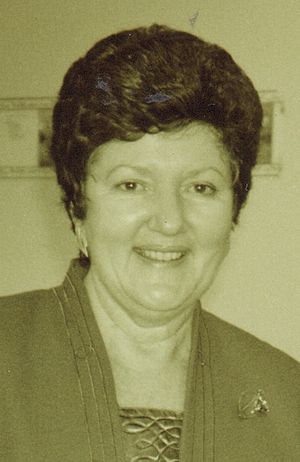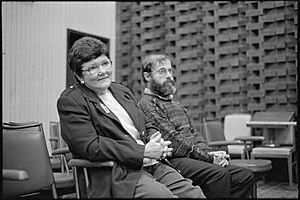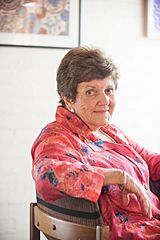Joan Kirner facts for kids
Quick facts for kids
Joan Kirner
|
|
|---|---|

Kirner in 1991
|
|
| 42nd Premier of Victoria Elections: 1992 |
|
| In office 10 August 1990 – 6 October 1992 |
|
| Monarch | Elizabeth II |
| Governor | Davis McCaughey Richard McGarvie |
| Deputy | Jim Kennan |
| Preceded by | John Cain Jr. |
| Succeeded by | Jeff Kennett |
| 22nd Deputy Premier of Victoria | |
| In office 7 February 1989 – 10 August 1990 |
|
| Premier | John Cain Jr. |
| Preceded by | Robert Fordham |
| Succeeded by | Jim Kennan |
| Leader of the Opposition of Victoria | |
| In office 6 October 1992 – 22 March 1993 |
|
| Premier | Jeff Kennett |
| Deputy | Jim Kennan |
| Preceded by | Jeff Kennett |
| Succeeded by | Jim Kennan |
| Leader of the Labor Party in Victoria | |
| In office 9 August 1990 – 22 March 1993 |
|
| Deputy | Jim Kennan |
| Preceded by | John Cain Jr. |
| Succeeded by | Jim Kennan |
| Member of the Victorian Legislative Assembly for Williamstown | |
| In office 1 October 1988 – 27 May 1994 |
|
| Preceded by | Gordon Stirling |
| Succeeded by | Steve Bracks |
| Member of the Victorian Legislative Council for Melbourne West | |
| In office 3 April 1982 – 30 September 1988 |
|
| Preceded by | Bon Thomas |
| Succeeded by | Licia Kokocinski |
| Personal details | |
| Born |
Joan Elizabeth Hood
20 June 1938 Essendon, Victoria, Australia |
| Died | 1 June 2015 (aged 76) Melbourne, Victoria, Australia |
| Political party | Labor |
| Spouse | Ronald George Kirner (m. 1960) |
| Children | Michael, Kate and David |
| Alma mater | University of Melbourne |
| Profession | Teacher |
| Signature |  |
Joan Elizabeth Kirner AC (born Joan Hood; 20 June 1938 – 1 June 2015) was an important Australian politician. She served as the 42nd Premier of Victoria from 1990 to 1992. As a member of the Labor Party, she was in the Parliament of Victoria from 1982 to 1994.
Before becoming Premier, Joan Kirner was a minister and also the deputy premier in the government led by John Cain Jr.. When Cain resigned, she became the Premier. She was the first woman to hold this top job in Victoria. She was also Australia's third female head of government. Her time as Premier ended when her party lost the state election in 1992.
Contents
Early Life and Education
Joan Elizabeth Hood was born in Essendon, a suburb of Melbourne, Australia. Her father worked with machines, and her mother was a music teacher. Joan went to both public and private schools.
She studied arts at the University of Melbourne and then became a teacher. She taught in public schools and became very involved in groups for parents and schools. From 1971 to 1977, she was the President of the Victorian Federation of States School Parents' Clubs. This group was important in influencing education. She also worked as an executive officer for the group and advised the government on education matters. In 1960, she married Ron Kirner, and they had three children.
Starting in Politics
Joan Kirner joined the Labor Party in 1978. In 1982, she was elected to the Victorian Legislative Council. This is the upper house of the Victorian Parliament.
In 1985, she joined the government of John Cain Jr. as the Minister for Conservation, Forests and Lands. In this role, she helped create the Flora and Fauna Guarantee Act 1988. This was the first law in Australia to legally protect rare plants and animals. She also helped start the first Landcare groups. These groups work to protect and restore the land.
In 1988, Kirner moved to the Legislative Assembly, which is the lower house of parliament. She became the MP for Williamstown. She was also put in charge of education. She made changes to the education system, including a new way of assessing students called the Victorian Certificate of Education.
Becoming Premier of Victoria
Later in 1988, Joan Kirner became the deputy leader of the Labor Party and the Deputy Premier of Victoria. When Premier Cain resigned in August 1990, Kirner was chosen to lead the Labor Party. This made her Victoria's first female Premier.
At this time, the government was facing many challenges. There were money problems, and the Labor Party was divided. People hoped that having a popular woman as leader would help. However, it was a very difficult time. Some newspapers were not kind to her, but she kept working hard. She gradually earned some respect, even though it was hard to improve the government's standing.
During 1991 and 1992, Kirner's government tried to save money and raise funds. They sold off some government assets, like the State Bank of Victoria, to the Commonwealth Bank in 1991.
The 1992 Election and After
In 1992, Joan Kirner knew that an election was coming. Opinion polls showed that her party was unlikely to win. She waited as long as she could before calling the election for October. It was clear that the Labor Party would not win a fourth term in power.
Even though Joan Kirner was personally more popular than the opposition leader, Jeff Kennett, it was not enough. People in Victoria were unhappy with the Labor government. The opposition party ran a strong campaign.
The election campaign had some controversy. The Labor Party ran ads saying that if the Liberals won, they would bring in policies similar to those in New Zealand. The New Zealand Prime Minister, Jim Bolger, made a comment about Kirner's weight, which caused some anger, especially among women in his own party.
The Coalition, led by Jeff Kennett, won the election by a large margin. Joan Kirner stayed on as the Leader of the Opposition for a short time before stepping down. She left Parliament in 1994. Her former aide, Steve Bracks, who later became Premier, took her place as the MP for Williamstown.
A painting of Joan Kirner, done by artist Annette Bezor in 1994, is displayed in Parliament House Victoria.
Life After Parliament
After leaving Parliament, Joan Kirner continued to be active in her community and in politics. She played a key role in the Landcare movement. She also pushed for the Labor Party to set goals for having more women candidates in elections they could win. She often supported candidates from her own political group.
From 2006, Kirner was the Chair of a special committee for Victorian Communities. She was also on the board of Museum Victoria, which runs places like the Melbourne Museum and Scienceworks Museum. She was a big fan of the Essendon Football Club.
In 1993, she appeared on a TV show called The Late Show. She performed a song called "I Love Rock 'n' Roll" with a colleague. This performance was talked about across the country.
In 2009, Kirner shared that she had a bad fall and had osteoporosis, a condition that weakens bones. She also said she was blind in one eye.
Death
In August 2013, it was announced that Joan Kirner had been diagnosed with oesophageal cancer. She passed away on 1 June 2015, just before her 77th birthday.
Honours and Legacy
Joan Kirner received several important awards for her service:
- On 26 January 1980, she was named a Member of the Order of Australia for her work in the community.
- On 1 January 2001, she received the Centenary Medal.
- On 11 June 2012, she was named a Companion of the Order of Australia. This was for her great service to the Parliament of Victoria and the community. This included her work in conservation, promoting equality for women, developing education programs, and fighting for civil rights.
In May 2017, the Victorian Government started the Joan Kirner Young and Emerging Women Leaders program. This program offers 25 scholarships to young women, honoring her contributions.
In May 2019, a new hospital for mothers and children at Sunshine Hospital was named the Joan Kirner Women's and Children's Hospital.
One of the large tunnel-boring machines used for the Metro Tunnel project in Melbourne is named Joan, in her honor. This machine started working on 15 August 2019.
See also
- List of female heads of government in Australia



